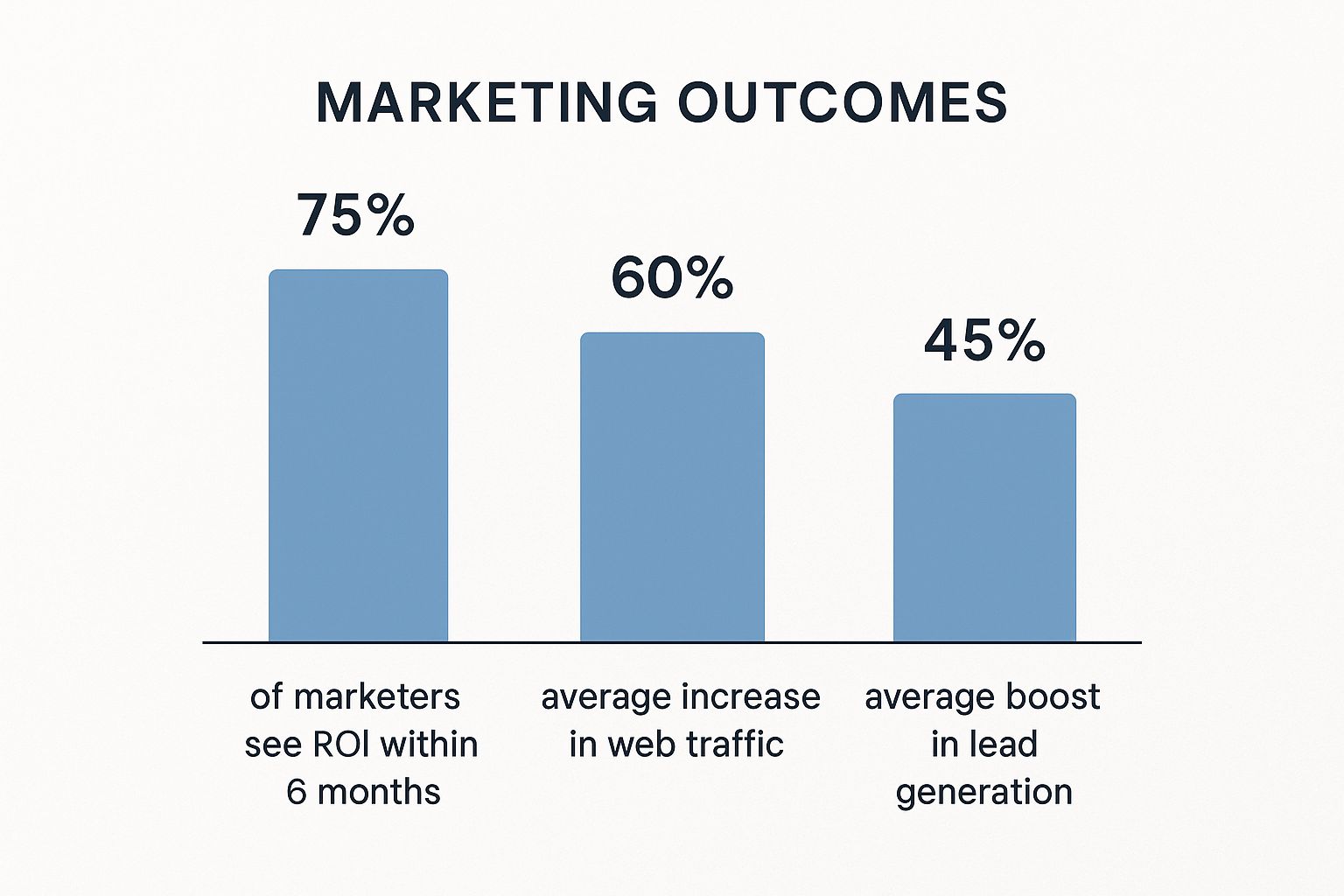Why Smart Businesses Are Winning With Blogs Right Now
More than ever, businesses are using blogs to connect with their target audience, build brand loyalty, and drive significant growth. This isn't about following a trend; it's about recognizing the power of a well-executed blog. A business blog helps you become a thought leader in your industry, offering valuable insights and expertise that build trust with potential customers. This fosters stronger relationships and encourages conversions.
Building Trust and Generating Leads
Imagine a software company consistently blogging about common customer pain points. By offering practical solutions and demonstrating a deep understanding of their audience's needs, they establish credibility and become a go-to resource. When prospects are ready to buy, they're more likely to choose the company they know and trust. A blog is also a powerful lead generation tool. By offering valuable content, you attract potential customers and capture their information through email sign-ups or other lead magnets.
The following infographic visualizes the impact a business blog can have:

As the infographic shows, 75% of marketers see a return on investment (ROI) within six months of starting a business blog. Businesses experience an average 60% increase in website traffic and a 45% boost in lead generation. This demonstrates the tangible benefits of blogging. Check out this guide on how to master blogging success.
The Evolving Landscape of Business Blogging
Business blogging is constantly evolving. The online world has changed dramatically, with estimates of over 600 million blogs worldwide as of 2025. This means nearly a third of all websites (out of approximately 1.9 billion) are blogs, highlighting their importance to digital communication and commerce. Approximately 6 million blog posts are published globally each day. Find more detailed statistics here.
The following table shows a comparison of the average ROI from blogging across different industries. This data provides a general overview and can help you understand the potential impact of a blog in your specific sector.
Business Blog ROI Comparison by Industry
| Industry | Average Traffic Increase | Lead Generation Impact | Time to ROI |
|---|---|---|---|
| Technology | 70% | 50% | 6 months |
| Healthcare | 55% | 40% | 9 months |
| Finance | 60% | 45% | 6 months |
| Retail | 65% | 55% | 3 months |
| Manufacturing | 50% | 35% | 12 months |
As you can see, retail businesses tend to see the fastest ROI, while manufacturing often takes longer. Across all industries, however, blogging provides a significant boost to both traffic and lead generation. You may also want to read how to start a business blog successfully. This underscores the need to create high-quality, consistent content that stands out.
Building Your Blog Strategy That Actually Works

A successful business blog needs more than just churning out articles. It requires a well-defined strategy. Many businesses skip this crucial planning stage and struggle to see a return on their investment. A strategic framework is essential to create content that turns potential customers into loyal ones. Let's explore how to build a blog strategy that delivers results.
Identifying Your Target Audience
Understanding your audience is the bedrock of any successful blog strategy. Who are you writing for? What problems are they facing? What kind of content are they looking for?
Answering these questions helps you tailor your content to resonate with the right people. For example, if you're selling project management software to small businesses, your blog posts might focus on topics like improving team communication or efficient project tracking.
Positioning Yourself Against Competitors
Once you know your audience, it's time to size up your competition. What are they doing well? What are their shortcomings? This analysis allows you to find opportunities to differentiate your blog and provide unique value.
Understanding your competitors also helps you discover untapped keyword opportunities and target specific audience segments they may be missing. This competitive analysis is vital for claiming your space in the online world.
Setting Achievable Goals
Setting clear, measurable goals is essential for tracking your blog's performance. Your goals should align with your overall business objectives.
Do you want to boost brand visibility? Are you aiming to generate leads? Is your main focus driving sales? Defining your goals helps you focus your content creation efforts and measure your success. This involves establishing key performance indicators (KPIs) to monitor your progress. Tools like Google Analytics can be instrumental in tracking these KPIs.
Developing a Content Calendar
A content calendar is your blog's roadmap, outlining what topics you'll cover and when. It keeps you organized and ensures consistent publishing. This helps you stay on schedule and avoid last-minute scrambles for content.
A consistent publishing schedule is key to building a loyal following and establishing your authority. Using a content management system (CMS) like WordPress can be a game-changer for scheduling and managing your content calendar.
Finding Your Unique Voice and Style
Developing a unique voice and style for your blog sets you apart from the competition. It builds your brand personality and connects with your readers.
Think about the tone and style that best reflects your brand. Are you going for informative and professional? Or more relaxed and conversational? Finding the right voice helps your content resonate with your target audience and foster brand loyalty.
Integrating Your Blog With Your Sales Process
Your blog shouldn't be an island. It needs to be integrated with your sales process and other marketing initiatives. Use your blog to nurture leads, educate potential customers, and guide them towards a purchase.
For example, include compelling calls to action in your blog posts, directing readers to product pages or landing pages. Using a CRM can significantly enhance this integration.
The following table outlines a checklist for planning your blog strategy. It details the key elements, their priority, estimated time investment, and the resources you might need.
Blog Strategy Planning Checklist Comprehensive checklist covering all essential elements of blog strategy development
| Strategy Element | Priority Level | Time Required | Resources Needed |
|---|---|---|---|
| Target Audience Identification | High | 4-6 hours | Market research tools, customer surveys |
| Competitor Analysis | High | 2-4 hours | Competitor websites, industry reports |
| Goal Setting | High | 1-2 hours | Business plan, marketing strategy |
| Content Calendar Development | Medium | 2-4 hours | Spreadsheet software, content management system |
| Voice and Style Definition | Medium | 1-2 hours | Brand guidelines, style guide |
| Sales Process Integration | High | 2-4 hours | CRM software, marketing automation tools |
By following these steps, you can build a blog strategy that delivers real results for your business, driving traffic, generating leads, and ultimately increasing your revenue. Building a thriving blog takes time and effort. Be patient, stay consistent, and continually refine your strategy as you learn what resonates best with your audience and your business.
Choosing Your Platform and Tools Like A Pro
The foundation of a successful business blog rests on the platform and tools you select. These choices have a long-term impact, influencing your blog's effectiveness for years to come. Fortunately, launching a business blog doesn't demand advanced coding skills. By focusing on essential elements like customization, SEO capabilities, scalability, and cost, you can make smart decisions that position your blog for growth.
Selecting the Right Blogging Platform
Your blogging platform is the heart of your online presence. For businesses, particular platforms shine due to their robust features and adaptability.
WordPress: Renowned for its extensive customization and vast plugin library, WordPress gives you significant control over your blog's design and function. This empowers you to tailor your blog precisely to your specific brand and business requirements.
BlogMaker: This premium service simplifies blog creation with a comprehensive, no-code approach. Offering features like SEO readiness, custom domains, and integrated newsletters, BlogMaker streamlines the technical side of blogging.
Shopify (Built-in Blog): If your business already uses Shopify for e-commerce, its integrated blogging platform provides a seamless connection with your online store. This is an excellent option for businesses seeking close integration between their blog and sales.
When choosing a platform, consider these key factors:
- Customization: How much control do you have over the look and feel of your blog?
- SEO: Does the platform provide built-in tools and features for search engine optimization?
- Scalability: Can the platform handle growing traffic and content as your blog expands?
- Cost: What are the initial and ongoing expenses associated with each platform?
Essential Tools for Streamlining Your Workflow
Beyond your chosen platform, various tools can significantly improve your blogging process.
Content Creation Tools: Grammarly and Hemingway Editor can polish your writing, ensuring clarity and readability.
SEO Tools: SEMrush and Ahrefs offer valuable data on keyword research and competitor analysis, enabling you to optimize your content for search engines.
Image Editing Tools: Canva and Adobe Photoshop allow you to craft visually engaging graphics and images for your blog posts.
The following table compares key features across various blogging platforms, highlighting their strengths and weaknesses to help you select the best fit for your business blog.
| Feature | WordPress | BlogMaker | Shopify (Built-in) |
|---|---|---|---|
| Customization | High | Medium | Medium |
| SEO Capabilities | High | High | Medium |
| Scalability | High | High | Medium |
| Cost | Varies | Flat | Included |
Hosting, Security, and Backups: The Technical Essentials
Selecting the right hosting provider is vital for your blog's performance and security. Prioritize providers with reliable uptime, fast loading speeds, and robust security measures. These aspects impact not only user experience but also your search engine rankings. Regular backups are also crucial for protecting your content. Make sure your chosen platform or hosting provider offers automated backup options to safeguard your valuable content against technical issues or data loss. Staying competitive means exploring emerging features and integrations that can give your business blog an edge. This might include incorporating interactive content, integrating with social media platforms, or using AI-powered writing assistants.
Creating Content That Converts Prospects Into Customers

Effective business blogging creates content that not only informs but also subtly encourages readers to become customers. It's a careful balancing act: providing valuable information while showcasing your expertise. Think of your blog posts as bridges, connecting reader needs with your solutions. This section explores how to build those bridges effectively for a blog that truly converts.
Balancing Information and Promotion
A key aspect of effective content is finding the right balance between genuine value and business promotion. Your focus should be on educating and engaging your audience. For example, if you sell accounting software, offer tips on simplifying tax preparation or managing finances.
Within these helpful posts, naturally mention your software as a solution. Avoid overt sales pitches. This builds trust and positions you as a helpful resource, not just another company pushing a product. You might be interested in: How to master content creation as a beginner.
Structuring for Readability and Engagement
Even the most valuable information won't convert if it's hard to read. Structure your posts for readability. Use short paragraphs, clear headings, bullet points, and visuals.
This approach makes content easier to scan and understand, increasing reader engagement. Like a well-organized store, a well-structured blog post guides readers to the information they need.
Effective Content Formats for Conversion
Different content formats serve different purposes. How-to guides demonstrate expertise and offer practical solutions. Case studies show how your product or service has helped others, providing social proof. Listicles offer digestible information and are great for social media.
Choosing the right format for your message and audience is crucial for impact. The rise of AI is also influencing content creation. Recent research suggests 80% of bloggers use AI tools as of 2024. Find more statistics here.
Storytelling and Addressing Pain Points
Stories resonate more deeply than facts. Use storytelling to connect with your audience emotionally and make your content memorable. Identify your customers' pain points and create content that addresses these challenges directly.
By showing empathy and providing solutions, you become a trusted advisor and increase the likelihood of conversion. This approach builds strong customer relationships, moving beyond information delivery to foster genuine engagement.
Mastering SEO Without Getting Lost In The Technical Weeds
Crafting engaging content is only one piece of the puzzle when launching a business blog. Even the most insightful articles won't attract leads if your audience can't find them. This is where Search Engine Optimization (SEO) comes into play. SEO is the process of refining your content to achieve higher rankings in search engine results. This section explores practical SEO strategies for business blogs, emphasizing attracting qualified prospects.
Keyword Research: Understanding Your Audience's Search Habits
Effective SEO starts with keyword research. Keywords are the words and phrases people use in online searches. Understanding these keywords offers direct insight into your customer's needs. Tools like SEMrush and Ahrefs can help pinpoint what your target audience is searching for.
For example, if your business sells accounting software, keywords like "small business accounting tips" or "best cloud-based accounting" might be relevant. This research provides valuable data about your audience and enables you to create content that truly resonates. This targeted approach ensures your content reaches the right people. You might be interested in: How to master blog post SEO with this checklist.
Optimizing Your Content: Speaking the Language of Search Engines
After identifying the right keywords, seamlessly integrate them into your content. This doesn't mean keyword stuffing, or excessively using keywords to manipulate search rankings. Instead, concentrate on creating high-quality content that offers real value to your readers.
This involves strategically placing keywords in key areas:
- Page titles: Use clear, concise titles that accurately reflect the post's topic, incorporating relevant keywords.
- Headings and subheadings (H2s and H3s): Structure your content with keyword-rich headings to improve readability and SEO.
- Body text: Naturally weave keywords into your writing, maintaining a conversational tone.
- Image alt text: Use keywords to describe your images, enhancing both SEO and accessibility.
Structuring Your Blog: Making it Easy for Search Engines to Crawl
Search engines use crawlers, also called bots or spiders, to scan and index your website's content. A well-structured blog makes it easy for these crawlers to navigate your site. This includes a clear site architecture, descriptive URLs, and fast loading speeds.
Internal linking, connecting pages within your blog, is another important factor. It helps distribute link equity and improves user engagement by guiding readers to related content. For example, an article about "starting a business blog" could link to another post on "content marketing strategies."
Local SEO: Connecting With Your Local Community
If your business caters to a specific geographic area, local SEO is crucial. This involves optimizing your blog for location-based searches. Key tactics include using location-based keywords, listing your business on Google My Business, and building local citations (mentions of your business on other websites).
These strategies boost your visibility to local customers searching for businesses like yours. Focusing on local SEO helps you connect with your community and draw in a more targeted audience.
Getting Your Content In Front Of The Right People

Crafting top-notch content is only the first step in a successful business blog. The real key is getting that content seen by the right people – your target audience. This requires a strategic approach to promotion and engagement, transforming casual readers into dedicated followers and, eventually, loyal customers. It's about fostering a thriving community around your blog.
Leveraging Social Media Effectively
Social media platforms are invaluable tools for blog promotion. However, trying to maintain a presence on every platform can quickly become overwhelming. Instead, identify the platforms your target audience frequents and concentrate your efforts there.
For instance, if you're targeting businesses, LinkedIn might be a more effective choice than Instagram. This focused strategy maximizes your impact without overextending your resources. Creating enticing social media posts that offer a glimpse into your blog content is crucial for attracting readers.
Building an Email List That Converts
An email list is an essential asset for any business blog. It provides a direct line of communication with your audience, allowing you to share new content and promote your products or services. Offer valuable lead magnets, such as free ebooks or checklists, to incentivize sign-ups.
Segment your list to personalize your messages and cater to specific reader interests. This targeted approach allows you to tailor content and offers, leading to higher conversion rates.
Creating Strategic Partnerships
Collaborating with other businesses or influencers in your niche can significantly broaden your reach. Seek out opportunities for co-creating content, cross-promoting each other’s blogs, and tapping into new audiences. These partnerships can expose your blog to a wider pool of potential readers.
Encouraging Genuine Social Sharing
Simplify content sharing for your readers by incorporating social sharing buttons directly on your blog. Craft compelling headlines and create visually engaging content that naturally encourages social media interaction.
Engaging With Comments and Feedback
Responding to comments and feedback demonstrates that you value your audience's input. This cultivates a sense of community and connection, strengthening relationships with your readers and encouraging further interaction.
Turning Readers Into Brand Advocates
Delivering exceptional value and building rapport with your readers can transform them into passionate brand advocates. Encourage them to share their positive experiences and recommend your blog to others. This organic word-of-mouth marketing is incredibly effective. You might be interested in: How to increase blog traffic.
Exploring Free and Paid Promotion Strategies
Numerous avenues exist for promoting your blog, both free and paid. Free options include social media marketing, guest posting, and SEO optimization. Paid strategies encompass social media advertising, influencer marketing, and sponsored content.
The optimal blend depends on your budget, objectives, and target audience. Experimentation is key to discovering the most effective strategies for your business blog.
Community Building and Guest Posting
Nurturing a community around your blog fosters loyalty and boosts engagement. Create opportunities for readers to connect through forums, social media groups, or online events. Guest posting on other relevant blogs can introduce your content to a new audience and build valuable backlinks to your site.
Measuring Engagement Metrics
Tracking relevant metrics provides insights into what resonates with your audience and what needs improvement. Prioritize metrics that align with business growth, such as lead generation, conversion rates, and customer acquisition cost. This data-driven approach allows you to refine your promotion strategies and maximize your ROI. Tools like Google Analytics can be invaluable for monitoring these metrics.
Measuring What Matters and Scaling Your Success
Building a successful business blog takes more than just writing great content. It requires understanding what connects with your audience and produces real results. This means looking past vanity metrics like page views and focusing on key performance indicators (KPIs) aligned with your business goals. This section explores how to measure what truly matters and scale your blog’s success as your business expands.
Setting Up Analytics for Meaningful Insights
The first step is setting up analytics systems to track the right data. Page views can give you a basic understanding of traffic, but they don't provide the complete picture. Instead, concentrate on metrics like lead generation, customer acquisition, and revenue attribution. This involves integrating your blog with analytics platforms like Google Analytics and potentially your CRM system.
For instance, track how many blog visitors subscribe to your email list, download a lead magnet, or make a purchase. This information provides a much clearer understanding of your blog's influence on your bottom line. This targeted approach ensures you're measuring data that directly contributes to your business objectives.
Essential KPIs for Business Blogs
Several KPIs are particularly important for business blogs. These include:
- Conversion Rate: The percentage of blog visitors who complete a desired action. This could be anything from making a purchase to filling out a contact form. A high conversion rate indicates your content effectively guides readers toward becoming customers.
- Lead Generation Rate: The number of leads generated through your blog demonstrates its effectiveness as a lead generation tool.
- Customer Acquisition Cost (CAC): The cost of acquiring a new customer through your blog. A lower CAC indicates a more efficient marketing strategy.
- Return on Investment (ROI): The overall return on your blog investment, factoring in elements like revenue generated and costs incurred.
Tracking these KPIs lets you evaluate your blog’s performance and find areas for improvement. You might be interested in: How to master content performance metrics.
Creating Reporting Systems and Optimizing Content
Develop reporting systems that present data clearly and inform strategic choices. Regularly review your blog’s performance and adjust your content strategy accordingly. For example, if certain blog topics generate more leads, create more content on those successful subjects.
This data-driven methodology ensures your blog stays aligned with your business objectives and continues driving results. It’s about using data to refine your approach, not just to collect it.
Scaling Content Production and Maintaining Quality
As your business and blog grow, you'll likely need to scale your content production. This could mean hiring a content team, outsourcing some writing tasks, or using content creation tools.
However, maintaining quality while increasing output is critical. Establish clear content guidelines, provide thorough training, and implement quality control processes. This ensures your blog maintains its voice and standards, even with a larger volume of content.
Long-Term Planning and Continuous Improvement
Long-term success requires a plan. Create a content roadmap outlining your blog's direction for the upcoming year or longer. This roadmap should include key themes, target keywords, and content formats.
Embrace continuous improvement. Regularly review your blog's performance, gather audience feedback, and experiment with new approaches. This constant optimization helps your blog stay relevant, engaging, and effective in achieving business goals.
Start publishing today with BlogMaker and experience the difference a strategically planned and executed blog can make for your business.
SEO–ready, Analytics, No–code.
Your Content Publishing Engine
Deliver your SEO–driven content!
Visit BlogMaker.app



